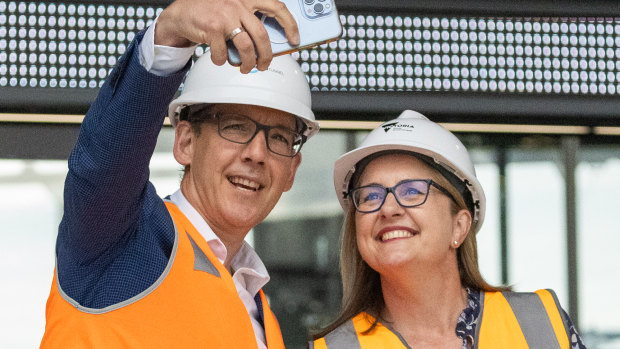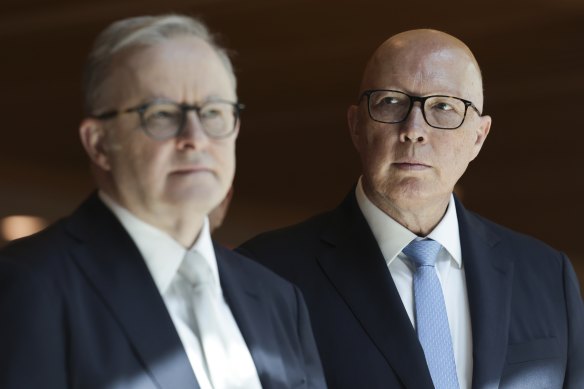- Exclusive
- Politics
- Victoria
- Immigration
Victoria lobbied for rule change to raise working visa cut-off age to 50
Victoria privately lobbied the Albanese government to increase the age limit for working holidaymakers from 30 to 50 as a way to address “critical” job shortages in the state’s tourism sector.
A ministerial brief, released under freedom of information laws, shows Victoria’s Tourism Minister, Steve Dimopoulos, instructed his department to write to then-immigration minister Andrew Giles in July 2023, seeking to expand visa requirements to attract more overseas workers.

Tourism Minister Steve Dimopoulos, pictured with Premier Jacinta Allan, asked the Albanese government to tinker with the visa system to attract more older workers to the state.Credit: Jason South
“Increasing the upper age limit to 50 years would help to alleviate workforce pressures due to the gradual return of international workers by creating a larger pool of potential workers,” said the brief, signed by Dimopoulos.
The change was in line with repeated calls at the time from Australia’s peak tourism body for the working holiday visa age cut-off to be lifted to 50.
The briefing note, released to the opposition, also revealed that Victoria asked the federal government to look at ways to “attract and retain skilled international graduates”, as well as potentially expanding the Pacific Island Australia Labour Mobility (PALM) scheme to include Asian countries.
The PALM scheme currently allows eligible Australian businesses to hire workers from nine Pacific Island nations and Timor-Leste when there are not enough local workers available.

Migration stands to be a key federal election issue for Anthony Albanese and Peter Dutton.Credit: Alex Ellinghausen
Dimopoulos suggested the Albanese government investigate the feasibility of duplicating the scheme into the Indo-Pacific region, noting “the strength of tourism workforces available in Thailand and Cambodia”.
The appeal to Giles also included a request to expand the number of regional locations where working holidaymakers could undertake “specified work” that qualifies them to extend their stay.
“Victoria currently has eight eligible postcodes covering remote regions of the state for work carried out in the tourism and hospitality industry ... Including more locations in regional Australia would help alleviate the shortfall in the supply of labour to critical tourism-related industries,” the briefing note said.
The proposals to expand low-skilled visas has prompted criticism from economist Leith van Onselen, who described the move as a “step backwards” that would do little to boost the economy, particularly when the state government was already struggling to keep up with housing needs.
“There are obviously pressure areas in the economy, but Australia should be aiming for a lower migrant intake but a higher skilled and higher paid cohort,” he said.
“We have a rental crisis in regional Victoria as well. Where is the infrastructure going to come from? We need to lower the numbers because we can’t build the housing infrastructure to cope.”
With immigration firming as a key federal election issue, the Albanese government used its May budget to revise down the number of permanent migration visas as part of a broader effort to halve migration in two years, from a record high of 528,000 in 2022-23, when borders reopened after the pandemic, to 260,000 by 2024-25.
The Coalition has also promised to slash migration visas from 185,000 to 140,000 for the next two years, then increase to 150,000 in 2026-27, with 160,000 each year after that.
Voters have also broadly backed cuts to migration with a survey from May, conducted for this masthead by Resolve Strategic, finding 66 per cent of voters believed the current intake was too high, while only 2 per cent thought it was too low.
Grattan Institute chief executive Aruna Sathanapally said while there were good reasons for the federal government to focus on bringing down migration, Australia continued to have a tight labour market and a short-term need for more workers in certain places.
“The greatest benefit to the economy is high-skilled workers, nonetheless, there are workforce shortages across the board,” she said.
“In the short term, you can see why particular employers would be looking to get labour wherever they can get it.”
Opposition Leader John Pesutto said the government’s focus should not be on tinkering with visa requirements.
“For years under Labor, skills shortages have been a handbrake of Victoria’s tourism sector and broader economy,” he said.
“Labor’s solution to workforce shortages isn’t to strengthen our local skills sector but to expand the working holiday visa program to 50-year-olds.”
Start the day with a summary of the day’s most important and interesting stories, analysis and insights. Sign up for our Morning Edition newsletter.